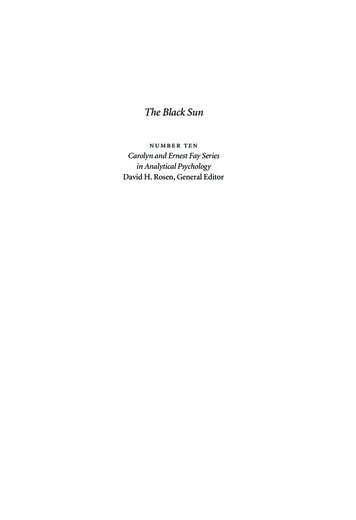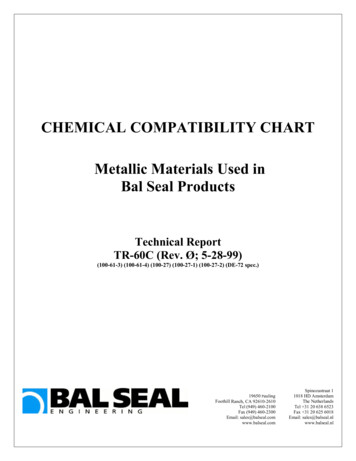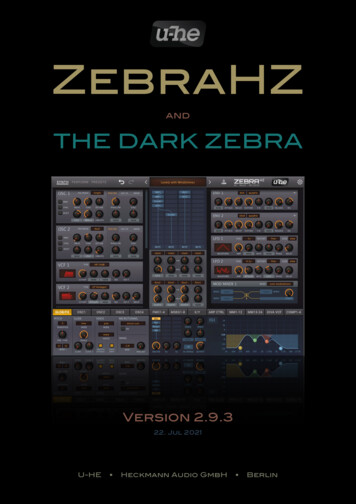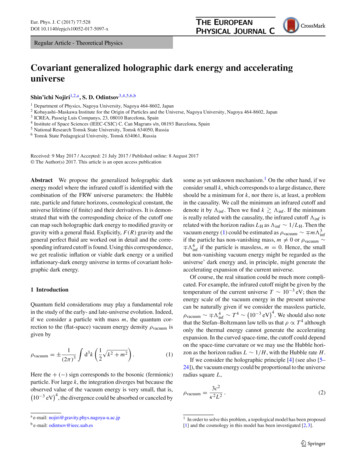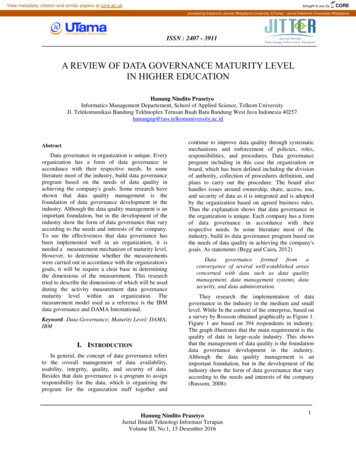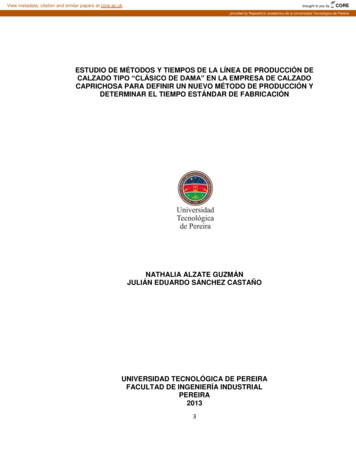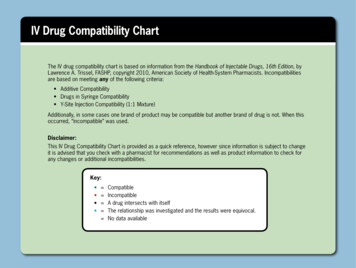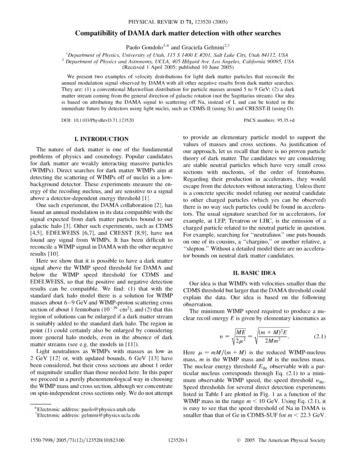
Transcription
PHYSICAL REVIEW D 71, 123520 (2005)Compatibility of DAMA dark matter detection with other searchesPaolo Gondolo1’* and Graciela Gelmini2,'{Department o f Physics, University o f Utah, 115 S 1400 E #201, Salt Lake City, Utah 84112, USA2 Department of Physics and Astronomy, UCLA, 405 Hilgard Ave. Los Angeles, California 90095, USA(Received 1 April 2005; published 10 June 2005)We present two examples of velocity distributions for light dark matter particles that reconcile theannual modulation signal observed by DAMA with all other negative results from dark matter searches.They are: (1) a conventional Maxwellian distribution for particle masses around 5 to 9 GeV; (2) a darkmatter stream coming from the general direction of galactic rotation (not the Sagittarius stream). Our ideais based on attributing the DAMA signal to scattering off Na, instead of I, and can be tested in theimmediate future by detectors using light nuclei, such as CDMS-II (using Si) and CRESST-II (using O).DOI: 10.1103/PhysRevD.71.123520PACS numbers: 95.35. dI. INTRODUCTIONThe nature of dark matter is one of the fundamentalproblems of physics and cosmology. Popular candidatesfor dark matter are weakly interacting massive particles(WIMPs). Direct searches for dark matter WIMPs aim atdetecting the scattering of WIMPs off of nuclei in a lowbackground detector. These experiments measure the en ergy of the recoiling nucleus, and are sensitive to a signalabove a detector-dependent energy threshold [11.One such experiment, the DAMA collaboration [2], hasfound an annual modulation in its data compatible with thesignal expected from dark matter particles bound to ourgalactic halo [31. Other such experiments, such as CDMS[4,5], EDELWEISS [6,7], and CRESST [8,9], have notfound any signal from WIMPs. It has been difficult toreconcile a WIMP signal in DAMA with the other negativeresults [10].Here we show that it is possible to have a dark mattersignal above the WIMP speed threshold for DAMA andbelow the WIMP speed threshold for CDMS andEDELWEISS, so that the positive and negative detectionresults can be compatible. We find: (1) that with thestandard dark halo model there is a solution for WIMPmasses about 6 - 9 GeV and WIMP-proton scattering crosssection of about 1 femtobarn (10-39 cm2), and (2) that thisregion of solutions can be enlarged if a dark matter streamis suitably added to the standard dark halo. The region inpoint (1) could certainly also be enlarged by consideringmore general halo models, even in the absence of darkmatter streams (see e.g. the models in [111).Light neutralinos as WIMPs with masses as low as2 GeV [121 or, with updated bounds, 6 GeV [131 havebeen considered, but their cross sections are about 1 orderof magnitude smaller than those needed here. In this paperwe proceed in a purely phenomenological way in choosingthe WIMP mass and cross section, although we concentrateon spin-independent cross sections only. We do not attempt Electronic address: paolo@physics.utah.edu'Electronic address: 20(10) 23.00to provide an elementary particle model to support thevalues of masses and cross sections. As justification ofour approach, let us recall that there is no proven particletheory of dark matter. The candidates we are consideringare stable neutral particles which have very small crosssections with nucleons, of the order of femtobams.Regarding their production in accelerators, they wouldescape from the detectors without interacting. Unless thereis a concrete specific model relating our neutral candidateto other charged particles (which yes can be observed)there is no way such particles could be found in accelera tors. The usual signature searched for in accelerators, forexample, at LEP, Tevatron or LHC, is the emission of acharged particle related to the neutral particle in question.For example, searching for “ neutralinos” one puts boundson one of its cousins, a “ chargino,” or another relative, a“ slepton.” Without a detailed model there are no accelera tor bounds on neutral dark matter candidates.II. BASIC IDEAOur idea is that WIMPs with velocities smaller than theCDMS threshold but larger that the DAMA threshold couldexplain the data. Our idea is based on the followingobservation.The minimum WIMP speed required to produce a nu clear recoil energy E is given by elementary kinematics as(m M ) 2E2M m 2(2 .1)Here fi m M / (m M ) is the reduced WIMP-nucleusmass, m is the WIMP mass and M is the nucleus mass.The nuclear energy threshold E thr observable with a par ticular nucleus corresponds through Eq. (2.1) to a mini mum observable WIMP speed, the speed threshold i/thr.Speed thresholds for several direct detection experimentslisted in Table I are plotted in Fig. 1 as a function of theWIMP mass in the range m 10 GeV. Using Eq. (2.1), itis easy to see that the speed threshold of Na in DAMA issmaller than that of Ge in CDMS-SUF for m 22.3 GeV.123520-1 2005 The American Physical Society
PAOLO GONDOLO AND GRACIELA GELMrNITABLE I.ExperimentPHYSICAL REVIEW D 71, 123520 (2005)Experimental constraints used in this study.Exposure [kg-day] Threshold Si: 6.58 Ge: 65.85Si: 5.26bGe : 52.610Ge: 8.2 cAl20 3:1.51CaW04:10.448DAMA/NaI-96Nal: 4123.2DAMA/NaI-03Nal: 107 731Efficiency [%]ConstraintRef.E 10 keV:7.6E 20 keV:22.85-55 keV: 2.3 events11[4]10-100 keV: 2.3 events11[5]keV: 2.3 events11d[6 ][8 ][9]E 2 0 keV:38E 20 keV2.3/i/keV - 8E 20 keV:43.75 E / 16ke V201000.610010100I: 2 2 eNa: 6.7eI: 2 2 eNa: 6.7e1002 0 -1 0 0Ca O, 15-40 keV: 6 eventsW, 12-40 keV: 2.3 events111-2 keVee: 1.4/kg-day-keVeer[14]2-3 keVee: 0.4/kg-day-keVeer[11 ]2-4 keVee:0.0233 0.0047/kg-day-keVeeg2-5 keVee:0.0210 0.0038/kg-day-keVeeg2-6 keVee:0.0192 0.003 l/kg-day-keVeeg6-14 keVee: - 0.0009 0.0019/kg-day-keVeeg100‘‘Upper limit assuming no detected event;bOnly one Si detector is used, the other having 14C contamination [4,5,15]; the Si efficiency is assumed to be the same as the Geefficiency, for which we take a simple analytic approximation to the curve in Fig. 3 of [5];cFinal EDELWEISS-I results [7] with 62 kg-days exposure do not give more stringent bounds because 59 events, attributed tobackground, have been detected between 10 and 200 keV;dTo reproduce the published curve in [8 ], we impose appropriate upper limits all along the recoil spectrum in their Fig. 1;eFrom an electron-equivalent threshold of 2 keVee, using the quenching factors Q E ./E equal to 0.09 for I and 0.3 for Na [11];approximations that reproduce the published ap vs m limit across our mass range;gAmplitude of annual modulation from the model-independent fit in [11] assuming a period of 1 yr. and the maximum counting rate atJune 2 .QI I I I I I I I I I I I I I I I I I I I I0246810m [GeV]FIG. 1 (color online). Threshold speeds uthr of several experi ments and target nuclei. The DAMA Na threshold is lower thanthe CDMS-SUF Ge threshold for m 22.3 GeV.To understand the dependence of the speed threshold onnuclear mass, consider the simple case m « M. Then fx *m is independent of the nucleus mass M, and i/thr isproportional to *jMExhs. Using the nuclear masses of Naand Ge, MNa 21.41 GeV and M Ge 67.64 GeV, andthe energy thresholds in Table I, the product M E xhs issmaller for Na in DAMA than for Ge in CDMS-SUF(notice that DAMA used “ clcctron-cquivalcnt" energies,which wc indicate with keVee units; these need to beconverted into nucleus recoil energies using the so-calledquenching factors listed in the caption of Table I). For m «M, the Ge i/thr in CDMS-SUF is 2.44 times the Na i/thr inDAMA.For m not necessarily much smaller than M, wc can referto Fig. 1. The speed threshold of Ge in CDMS-SUF, of Siand Ge in CDMS-II, of Ge in EDELWEISS, as well asthose of other experiments using heavier nuclei, arc largerthan the speed threshold of Na in DAMA in the WIMPmass range shown. Three light nuclei, namely, Si in CDMSand Al and O in CRESST, have speed thresholds lowerthan Na in DAMA, and can be used to test and constrainour idea.A small component of Si is present in CDMS. Si islighter than Ge, although heavier than Na, MSi 26.16 GeV. Given the nuclear energy recoil thresholds inTable I, the speed threshold of Si in CDMS-SUF is smaller123520-2
COMPATIBILITY OF DAMA DARK MATTER DETECTIONthan that of Na in DAMA for all WIMP mass values.However, considering the CDMS-SUF efficiency close to5 keV energies is about 8%, the effective exposure of theCDMS-SUF Si detector near threshold is about 0.5 kg-day,which may be too small to have detected the signal whichDAMA might have seen in its Na detector. In any event,CDMS has not yet used its Si component to set limits ondark matter, but only to help in background rejection.Light nuclei are used by CRESST, in particular, O( M 0 14.90 GeV).CRESST-I [81 used sapphire(A120 3), which besides O contains Al, similar in mass toSi. CRESST-I has set limits on dark matter with a very lownuclear recoil threshold of 0.6 keV, but with a small expo sure of only 1.5 kg-day. The speed threshold for O inCRESST-I is so low that CRESST-I is sensitive to thebulk of the halo dark matter particles we are proposing.CRESST-II uses calcium tungstate (C aW 04), which alsocontains the light O nucleus, but background discrimina tion sets a relatively high threshold of 10 keV. CRESSTII has run a prototype without neutron shield and set thelimits quoted in Table I [9]. The completed CRESST-II willtest our idea.In summary, for light enough WIMPs it could be pos sible to have dark matter WIMPs with a speed abovethreshold for Na in DAMA, and below threshold for Gein CDMS and EDELWEISS. That is, we could have a darkmatter signal visible for DAMA but not observable inCDMS and EDELWEISS and compatible with all experi mental data.III. METHODOur procedure is the following. Given a dark halomodel, including the WIMP velocity distribution, we findthe viable region by making sure that we produce thecorrect amplitude for the DAMA modulation in the viableregion and that all of the current experimental constraintsare satisfied.We consider constraints from DAMA/NaI-96 [14],DAMA/NaI-03 [11], EDELWEISS [6], CDMS-SUF [4],CDMS-Soudan [51, CRESST-I [81, and CRESST-II [91.The experimental exposures, efficiencies, thresholds, andconstraints we use are listed in Table I.To compute the number of recoil events in a givendetector we start by defining the effective exposure ofeach nuclear species i in the detector (expressed in kgdays of isotope /) as i 7',e,(/-;).(3.1)where Tt is the active time of the detector during which amassof nuclei of species i is exposed to the signal, and )(E) is the counting efficiency for nuclear recoils ofenergy E (for the counting efficiency we assume the valuesin Table I). Then the expected number of recoil events withrecoil energy in the range ( E lr E 2) is the following sumover the nuclear species in the detector,PHYSICAL REVIEW D 71, 123520 (2005)N* - * Z f * § w(3-2)E-Here d R j / c l E is the expected recoil rate per unit mass ofspecies i per unit nucleus recoil energy and per unit time. ItisdRj per j\F j{E)\2J2rnfl 'jdEf ( v , t) d3v.(3.3)VIn Eq. (3.3), M t is the mass of a nucleus of species i, m isthe WIMP mass, yti, mM- Jiin M () is the reducedWIMP-nucleus mass, p is the local halo WIMP density,Fj(E) is a nuclear form factor for species i (see below),is the WIMP-nucleus cross section, v is the velocity of theWIMP with respect to the detector, v v , and f ( \ , t) isthe WIMP velocity distribution in the reference frame ofthe detector.In this analysis, we assume that the WIMP-nucleusinteraction is spin-independent. We make the usual as sumption [11 that the cross sectionscales with thesquare of the nucleus atomic number A h Thus, in termsof the WIMP-proton cross section crp, the scaling is cr,- o-pAf(ju,t/ju,p)2. For the nuclear form factor we use theconventional Helmi form [11, F,-(E) 3e 9'-s'/ 2[sm (qr) —q r c o s ( q r ) ] / ( q r ) 3, with 5 1 fm, r 'JR2 — 5 s 2, R 1.2A j /3 fm, q J2M E.A technical point: DAMA obtains the nuclear recoilenergy E not directly but as a multiple of a measuredelectron-equivalent energy ee QE. The quenching fac tor Q depends on the nuclear target and has been foundexperimentally [111 to have the values QNa 0.3 andQi 0.09. DAMA results are quoted in electronequivalent energy (keVee), and Eq. (3.2) needs to be modi fied toNvXr ' e m d E .(3.4)The time dependence of the WIMP distribution function/(v, t) is due to the revolution of the Earth around the Sun[31. This gives rise to a modulation in the expected count ing rate with a period of a year. For a conventional halo, thecounting rate varies approximately sinusoidally [31, whilefor other halo models, in particular for models withstreams, the time dependence is in general not sinusoidal[161. We define the amplitude of the annual modulation ashalf of the difference between maximum and minimumcounting rates. Explicitly, for the ( ee i, Eee 2) electronequivalent energy interval in DAMA, the modulation am plitude in counts/kg-day-keVee is1JZl i[ rD max2LKEwl-Eet''P min, -E*J,(3.5)E are the maximum andwhere 3 i?“ E :e andminimum values of the counting rate during the course of123520-3
PAOLO GONDOLO AND GRACIELA GELMINIPHYSICAL REVIEW D 71, 123520 (2005)a year per kg-day-keVeeft,-:. DAMA ee,2 ee,l(3 -6 )Here ?dama (- Na M \ ) T is the DAMA exposure aslisted in Table I.We need to fix the WIMP velocity distribution. In thispaper we consider either a conventional Maxwellian dis tribution or the conventional Maxwellian distribution plusa dark matter stream (we discuss these two choices sepa rately in the next sections).In both cases, we proceed to vary the WIMP mass andthe parameters in the velocity distribution. For each choiceof these variables we find the range of WIMP-proton crosssections a p that produce the desired modulation amplitudeJA in DAMA/Nal at the 3tr or 90% confidence level. Indetail, let J A2- e be the expected modulation in the 2 6 keVee bin of DAMA/NaI-03, as computed usingEq. (3.5), and let J A 2 A SJA. 2 6 be the modelindependent experimental fit to the annual modulationamplitude with a fixed period of 1 yr and maximum rateJune 2, as provided by the DAMA collaboration in f i l l andlisted in Table I (i.e. J21?A6MA 0.0233 0.0047 counts/kg-day-keVee). Analogously, define thequantities JZL6 14 and J A 4A S J A 4A for the 6 -1 4keVee energy bin. To find the best-fit value of a p weminimize the quantity, ( A 2- 6 - JZI?AMAV , ( A 6- u xvs jz u ? A)vs jz i Aour condition. Since the 2 - 4 and 2 - 6 keVee bins arecorrelated, we show results for both.Our procedure differs from previous theoretical analyses[10] in that we use the modulation amplitudes provided byDAMA in their model-independent analysis [11] instead oftheir best-fit values obtained fixing the shape of the nuclearrecoil spectrum to that appropriate for the conventionalhalo model [14]. The latter best-fit values depend on theconventional recoil spectrum at the specific best-fit WIMPmass of DAMA (52 g GeV). Thus we must use themodel-independent fit to consider different WIMP massesand nonconventional halo models.Having found a WIMP-proton cross section that pro duces the DAMA annual modulation at n-sigma (or 90%)confidence, we evaluate the expected number of events inall of the other experiments using Eq. (3.2), and comparethem with the constraints in Table I. We require that lessthan 2.3 events are predicted for each experiment thatobserves no events (this is the 90% C.L. upper bound).All other upper bounds in Table I are also at 90% C.L. Wethus determine if the parameters we choose are compatiblewith all the experimental constraints we impose.We take an additional step in the case in which a darkmatter stream is added to the conventional halo model.After having followed the procedure described so far, wedetermine the minimum and maximum values of theWIMP mass for which there is a (part of the) a p confidenceinterval that produces the DAMA annual modulation and isallowed by all other experiments at 90% C.L.rIV. CONVENTIONAL HALO MODEL(3 .7 )This gives us xhin anc p,min- We accept the value a pminonly ifAmin 2-(3 .8 )Then we determine a n a confidence interval for a p byimposing that A -2 x 2( a p) — Xm-m satisfiesA x 1 n 1,(3.9)and a 90% confidence interval by imposing thatA * 2 2 .7 1 .(3.10)These are the appropriate values of A -2 for two data points( J L 2-6 and J2L6 i4) and one parameter ( a p) (see, e.g., theStatistics section in [17]).We have also replaced the 2 - 6 keVee bin with the 2 4 keVee bin. One obtains larger regions of a p satisfying/h(v, t) Nh(2 n cSince the experimental bounds on the candidate massand cross section depend on the halo model adopted, alldark matter direct detection experiments conventionallyadopt the same isothermal halo model, to be able to com pare their results. In this section, we adopt the same con ventional halo model, so as not to innovate in this respect.We make no claim that this is a realistic halo model, but itoffers us a definite benchmark for comparison.The value of the local WIMP density conventionallyadopted in direct detection comparisons is p 0.3 G eV /cm 3. This we adopt.The conventional WIMP velocity distribution used inthe comparison of direct detection experiments is aMaxwellian distribution truncated at the local galacticescape speed v esc. In the reference frame of the detector,which we take to coincide with the reference frame of theEarth, the conventional WIMP velocity distribution readslv v o v « W I‘ / 2 "0jf vI V0I Ve ( / ) V esc,“ I* ' *0 ' *ew i - « / esc,otherwise.,4 . 1 ,Here v is the velocity of a WIMP relative to the Earth, y @(t) is the velocity of the Earth relative to the Sun, and vQ is thevelocity of the Sun relative to the galactic rest frame, with respect to which the halo WIMPs are assumed to be stationary.123520-4
PHYSICAL REVIEW D 71, 123520 (2005)COMPATIBILITY OF DAMA DARK MATTER DETECTION . . .10-3 8TH I MI T b)X10 - 3 910 - 4 0o0246m [GeV]810 - 4 110c o n v e n tio n a lG a la c tic h a lo (2 —4keV ee)LJ I I I I I I I I l l I I I I I I L0246m [GeV]810FIG. 2 (color online). Comparison of the DAMA annual modulation region with other direct detection bounds for spin-independentWIMP-proton interactions and a conventional dark halo. In (a) the 2 -6 and 6-14 keVee DAMA bins and in (b) the 2 -4 and 6 14 keVee DAMA bins were used. In the hatched region, the WIMP-proton cross section rp at WIMP mass m reproduces the DAMAannual modulation results at the 90% and 3 r C.L. (inner densely hatched region and outer hatched region, respectively). The regionabove cach other line is cxcludcd at 90% C.L. by the corresponding experiment (DAMA/NaI-96, CRESST-I and II, EDELWEISS,CDMS-SUF and CDMS-Soudan [denoted by CDMS-S.]). In (a), there is a region compatible with the DAMA annual modulation andall other experiments at the 3 r but not the 90% C.L. In (b), there is a compatible region at the 90% C.L. also.Moreover, rh is the velocity dispersion of the WIMPs, andN h erf(z/V ) - {2/Tr)x/2z e z 2, with z uesc/o-h, is anormalization factor.For ve(0, we assume a magnitude of 29.8 km/s and adirection tangent to a circular orbit on the ecliptic plane.For vQ, wc assume the conventional value adopted in ourfield, namely, 232 km/s in the direction with ecliptic coor dinates / \ 0 340 , /30 60 .'Wc set the velocity dispersion to the conventional value rh 2 2 0 /% /2 k m /s (as applies to an isothermal model),and wc take the escape speed from the galaxy to be v esc 650 k m /s. With the halo model wc assume, the maximumpossible heliocentric velocity of a halo particlc is u esc v Q 882 km /s.Following the procedure discussed in Sec. Ill, wc obtainthe results in Figs. 2(a) and 2(b). In these figures wc showall the experimental bounds on the WIMP-proton crosssection and mass that wc obtain using the content ofTable I, together with the region where the DAMA modu lation is well reproduced at the 90% C.L. (denser central'This velocity of the Sun in the galactic rest frame is conven tional in our field. It consists of the IAU rccommcndcd value of2 2 0 km/s for the galactic rotation speed plus the proper motionof the Sun. In reality, estimates of the local galactic rotationspeed range from 170 km/s to 250 km/s (see e.g. [18]) and theSun’s proper motion is subjcct to statistical and systematic errorsof the order of 10 km/s.hatched region) and 3 a C.L. (hatched region). Figures 2(a)and 2(b) show the DAMA region obtained by using their2 - 6 and 6 -1 4 keVee data bins [Fig. 2(a)] and their 2 - 4and 6 -1 4 keVee data bins [Fig. 2(b)]. Also shown arc theregions cxcludcd by the experiments in Table I (DAMA/NaI-96, CRESST-I and II, EDELWEISS, CDMS-SUF, andCDMS-Soudan). In Fig. 2(a), there is a region compatiblewith the DAMA annual modulation and all other experi ments at the 3o- but not the 90% C.L. (notice that theexperimental bounds arc at the 90% C.L. and would beless stringent at the 3o- level). In Fig. 2(b), there is acompatible region at the 90% C.L. also. Sincc the 2 - 4and 2 - 6 keVee data bins arc correlated, wc do not have ameans of saying if using one or the other is better. Thus wcconclude that the agreement of DAMA with all otherexperiments is marginal when using the standard halomodel. This means, though, that wc expect a larger, moreconvincing, region of compatibility between DAMA andall the other experiments if the halo model is extendedbeyond the conventional model, for example, using themodels in Ref. [11] or, as presented in the next section,introducing additional components to the dark halo, suchas a dark matter stream.V. A D D ITION AL DARK M A TTER STREA MIn this section, wc add a stream of dark matter to theconventional halo model. In this wc follow the spirit of123520-5
PAOLO GONDOLO AND GRACIELA GELMINIPHYSICAL REVIEW D 71, 123520 (2005)[16,19-21], but look for a stream with velocity abovethreshold for Na in DAMA and below threshold for Gein CDMS. Although the stream gives the dominant signalin DAMA (because there are few halo WIMPs above theDAMA threshold), the signal due to the bulk of the halo(e.g. in CRESST) is not significantly affected.We include the dark matter stream by letting the WIMPvelocity distribution be the sum of the conventional veloc ity distribution / h(v, t) of the previous section and a con tribution from the dark matter stream / str(v, t),f(w, t) / h(v, t) / str(v, t).(5.1)For the stream contribution, we assume a Gaussian func tion stationary relative to the stream and with velocitydispersion crstr. In the Earth reference frame, the streamvelocity distribution is/ str(v, t) (5.2)(277tr2tr)3/2Here f str is the local dark matter density in the stream (inunits of the mean local halo density p 0.3 G eV /cm 3), vis the velocity of the WIMP relative to the Earth, v m{t) isthe velocity of the Earth relative to the Sun, and vstr is thevelocity of the stream relative to the Sun (heliocentricvelocity).We fix the stream velocity dispersion crstr 20 k m /s.Factor-of-2 variations of this value lead to small changes inthe results. We consider stream density fractions f str of upto 3%. Detailed studies of the evolution of possible residualsubstructure in the galactic dark halo concluded that thereis a high probability for the Earth to be passing through adark matter clump or stream with density —3% of the meanlocal halo density [21]. Ref. [21] studied mostly clumpsthat have orbited the Galaxy between 1 and 4 times(although mentioning that clumps that have orbited theGalaxy more times can also produce cold, high velocitystreams in the solar neighborhood) and found plausibleclump velocities relative to Earth of 400 to 700 km/s andvelocity dispersions of 20 to 50 km/s. The dark matterstream may also be of extragalactic origin. We commentabout this possibility later.Instead of the direction of vstr, we specify the eclipticcoordinates (Astr, jSstr) of the arrival direction of the stream,i.e. the direction of —vstr. This we do to be able to comparedirectly with the arrival direction in the conventional halomodel, which is the direction of motion of the Sun in thegalactic rest frame (A0, /3e ) (340 , 60 )In order to account for the DAMA annual modulation,the stream arrival direction is limited by the requirementthat the DAMA modulation peaks May 21 22 days. Tofind the direction of the Earth velocity at that time, wereason as follows. May 21 is 61 days after the Springequinox (March 21), and thus the Sun is at ecliptic longi tude 61/365.25 X 360 60 . Since the radius vector tothe Sun and the velocity of the Earth are almost perpen dicular (they are exactly so for a circular orbit), May 21 theEarth is moving toward a point of ecliptic longitude 60 90 330 . If the DAMA annual modulation is due en tirely to a stream, its arrival direction on Earth should haveecliptic longitude A 330 2 2 . Since we use themodulation amplitudes obtained by DAMA assuming aphase such that the maximum rate occurs on June 2, wefix the ecliptic longitude of the arrival direction of thestream at A 340 . The amplitude of the modulationdepends on the projection of the stream velocity onto theecliptic, and is proportional to cos/3str, where /3str is theecliptic latitude (i.e. the angle above the plane of theecliptic) of the stream arrival direction.We let the magnitude of vstr vary between u str 0 andv str 1200 km /s, thus allowing for both galactic andextragalactic streams (i.e. streams bound or not boundto the Galaxy). A stream is unbound if itsgalactocentric speed vstr vQ exceeds the local escapespeed. In formulas, the stream is extragalactic ifv sttr v e cos(f [fesc — v s in 2 4 ]1 2 wherecos j cos/3str cos/30 cos(Astr - A0).Streams bound to our own galaxy have been observed,for example, the tidal streams of the Sagittarius dwarfgalaxy [22], The Sagittarius leading tidal stream mightpass through or close to the solar neighborhood, with agalactocentric speed of 200 km /s, but its arrival direc tion (ASgr, /3sgr) (187 , 8 ) does not have the correctecliptic longitude to give the observed phase of theDAMA modulation without a substantial contributionfrom the usual halo component. So the stream we areimplying should be a different, perhaps yet undiscovered,stream.There may be dark matter bound not to our galaxy but toour Local Group of galaxies [23], and also dark matterbound to our supercluster, possibly passing through us[20]. A stream made of such dark matter has its galacto centric incoming speed uin at large distances from theGalaxy increased by gravitational focusing while fallinginto the Galaxy. Its resulting galactocentric speed near theSun is U 0Ca y j v 2n v 2sc. Its velocity dispersion mayincrease by a factor v ]oca]/ v jn if the stream self-gravity isnegligible, or remain approximately constant in selfgravitating regions of the stream. To give an idea of thegalactocentric velocities involved, a stream with arrivaldirection (Astr, j8str) (340 , 0 ) and heliocentric speedVstr 800 k m /s requires a local galactocentric speeduiocai 712 km /s, and, accounting for gravitational fo cusing, a galactocentric incoming speed at large distancesuin 293 km /s. This value is of the same order of mag nitude as the galactic speed relative to the cosmic micro wave background (CMB) (549 km/s, using the CMB dipolemeasurement in Ref. [24] and the conventional galacto centric velocity of the Sun in Sec. IV).The density of an incoming stream is also increased byfocusing, at least linearly with the ratio v ]oca]/ v in (see the123520-6
COMPATIBILITY OF DAMA DARK MATTER DETECTION . . .argument in Ref. [20]), but possibly by much larger factors,which are however complicated to evaluate. To have a localstream density fraction of the order of a few percent andgalactocentric incoming speeds v-m 1 0 0 km /s, the den sity of the infalling dark matter at infinity must be of theorder of the local halo density. This may be possible if asmall dark galaxy bound to our supercluster happens toPHYSICAL REVIEW D 71, 123520 (2005)cross our own. Diffuse dark matter bound to the LocalGroup of galaxies is expected to have a much smallerdensity. The average density of the Local Group of galaxiesis of the order of 2.2 times the critical density, i.e. 0.6 X10 - 5 GeV cm” 3, which is only 2 X 10 - 5 of the local halodensity. In order for a stream with say 0.1 of the averagedensity far away from our Galaxy to reach a density of 3%10 - 3 810 - 3 8E a)%(b%-1 0 - 39o1 0 - 39--4 0o10 - 4 01 01 0 -4 1201 0-3 846m [GeV]810 - 4 1100246m [GeV]8100246m [GeV]81010 - 3 8i r (c) x-C R ESST-I- DAMA-961 0-3 910 - 3 9OOaOh10-4 010 - 4 0h a lo 3% s t r e a m XJ1v str 9 0 0 k m / s100 str O Xstr 3 4 0J I I I I I I I I I L-4 10246m [GeV]810 - 4 110FIG. 3 (color online). Same as Fig. 2(a) but with the addition of a dark matter stream with density 3% of the conventional local halodensity, heliocentric arrival direction of ecliptic coordinatesf3hU) (340 , 0 ), and heliocentric speed of (a) 300 km/s,(b) 600 km/s, (c) 900 km/s, and (d) 1200 km/s. The DAMA modulation region is shown both for the 90% and the 3 a C.L. (innerdensely hatched and outer hatched regions, respectively). The gaps in the DAMA modulation region in panels (c) and (d) are due to ourrequirement that xl m - The experimental upper limits change when the stream is included.123520-7
PAOLO GONDOLO AND GRACIELA GELMrNIPHYSICAL REVIEW D 71, 123520 (2005)of the local halo density in the solar neighborhood, afocusing enhancement factor of 1.5 X 104 is needed. Thiscould only be possible if vin, the velocity of the stream withrespect to our galaxy, is close to zero, i.e. if the stream orclump of dark matter was initially almost at rest withrespect to our Galaxy (in this case
standard dark halo model there is a solution for WIMP masses about 6-9 GeV and WIMP-proton scattering cross section of about 1 femtobarn (10-39 cm2), and (2) that this region of solutions can be enlarged if a dark matter stream is suitably added to the standard dark halo. The region in point (1) could certainly also be enlarged by considering

